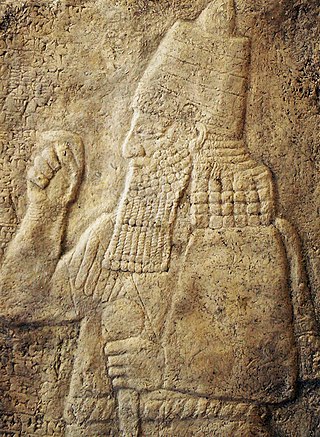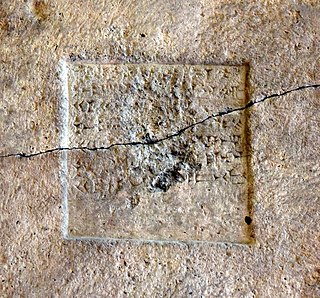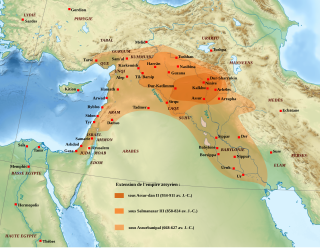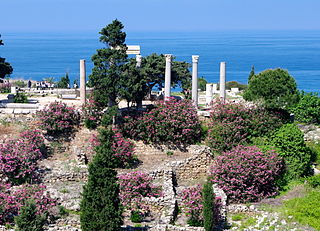
Sennacherib was the king of the Neo-Assyrian Empire from the death of his father Sargon II in 705 BC to his own death in 681 BC. The second king of the Sargonid dynasty, Sennacherib is one of the most famous Assyrian kings for the role he plays in the Hebrew Bible, which describes his campaign in the Levant. Other events of his reign include his destruction of the city of Babylon in 689 BC and his renovation and expansion of the last great Assyrian capital, Nineveh.

Canaan was a Semitic-speaking civilization and region of the Southern Levant in the Ancient Near East during the late 2nd millennium BC. Canaan had significant geopolitical importance in the Late Bronze Age Amarna Period as the area where the spheres of interest of the Egyptian, Hittite, Mitanni, and Assyrian Empires converged or overlapped. Much of present-day knowledge about Canaan stems from archaeological excavation in this area at sites such as Tel Hazor, Tel Megiddo, En Esur, and Gezer.
A vassal state is any state that has a mutual obligation to a superior state or empire, in a status similar to that of a vassal in the feudal system in medieval Europe. Vassal states were common among the empires of the Near East, dating back to the era of the Egyptian, Hittite, and Mitanni conflict, as well as Ancient China. The use of vassal states continued through the Middle Ages, with the last empire to use such states arguably being the Ottoman Empire, though some say that the British Empire had vassal states as well.
Kadesh, or Qadesh, was an ancient city of the Levant on or near the headwaters or a ford of the Orontes River. It was of some importance during the Late Bronze Age and is mentioned in the Amarna letters. It was the site of the Battle of Kadesh between the Hittite and Egyptian empires in the 13th century BC.
Ashur-nadin-ahhe II was king of Assyria from c. 1400 to 1391 BC. Preceded by Ashur-rim-nisheshu, he was succeeded by his brother, Eriba-Adad I.

The Amarna letters are an archive, written on clay tablets, primarily consisting of diplomatic correspondence between the Egyptian administration and its representatives in Canaan and Amurru, or neighboring kingdom leaders, during the New Kingdom, spanning a period of no more than thirty years between c. 1360–1332 BC. The letters were found in Upper Egypt at el-Amarna, the modern name for the ancient Egyptian capital of Akhetaten, founded by pharaoh Akhenaten (1350s–1330s BC) during the Eighteenth Dynasty of Egypt.
Aya-ramu was king of Edom around the year 701 BCE, during the reign of the Assyrian king Sennacherib. He is mentioned on Sennacherib's Prism in a list of kings of the Levant and Cyprus who paid tribute to Assyria after Sennacherib's campaign in the Levant.

Shammuramat, also known as Sammuramat or Shamiram and Semiramis, was a powerful queen of the Neo-Assyrian Empire. Beginning her career as the primary consort of the king Shamshi-Adad V, Shammuramat reached an unusually prominent position in the reign of her son Adad-nirari III. Though there is dispute in regard to Shammuramat's formal status and position, and if she should be considered a co-regent, it is clear that she was among the most powerful and influential women of the ancient Near East; she is the only known Assyrian queen to have retained her status as queen after the death of her husband and the only known ancient Assyrian woman to have partaken in, and perhaps even led, a military campaign.

Sumur was a Phoenician city in what is now Syria. It was a major trade center. The city has also been referred to in English publications as Simyra, Ṣimirra, Ṣumra, Sumura, Ṣimura, Zemar, and Zimyra.

Abdi-Ashirta (Akkadian: 𒀵𒀀𒅆𒅕𒋫 Warad-Ašîrta [ARAD2-A-ši-ir-ta]; fl. 14th century BC) was the ruler of Amurru who was in conflict with King Rib-Hadda of Byblos.

The Neo-Assyrian Empire was the fourth and penultimate stage of ancient Assyrian history. Beginning with the accession of Adad-nirari II in 911 BC, the Neo-Assyrian Empire grew to dominate the ancient Near East throughout much of the 8th and 7th centuries BC, becoming the largest empire in history up to that point. Because of its geopolitical dominance and ideology based in world domination, the Neo-Assyrian Empire is by many researchers regarded to have been the first world empire in history. It influenced other empires of the ancient world culturally, administratively, and militarily, including the Babylonians, the Achaemenids, and the Seleucids. At its height, the empire was the strongest military power in the world and ruled over all of Mesopotamia, the Levant and Egypt, as well as parts of Anatolia, Arabia and modern-day Iran and Armenia.

The Ahlamu; or Aḫlamū, were a group or designation of Semitic semi-nomads. Their habitat was west of the Euphrates between the mouth of the Khabur and Palmyra.

Amurru was an Amorite kingdom established c. 2000 BC, in a region spanning present-day Northern Lebanon and north-western Syria.

The timeline of ancient Assyria can be broken down into three main eras: the Old Assyrian period, Middle Assyrian Empire, and Neo-Assyrian Empire. Modern scholars typically also recognize an Early period preceding the Old Assyrian period and a post-imperial period succeeding the Neo-Assyrian period.

The Sargonid dynasty was the final ruling dynasty of Assyria, ruling as kings of Assyria during the Neo-Assyrian Empire for just over a century from the ascent of Sargon II in 722 BC to the fall of Assyria in 609 BC. Although Assyria would ultimately fall during their rule, the Sargonid dynasty ruled the country during the apex of its power and Sargon II's three immediate successors Sennacherib, Esarhaddon and Ashurbanipal are generally regarded as three of the greatest Assyrian monarchs. Though the dynasty encompasses seven Assyrian kings, two vassal kings in Babylonia and numerous princes and princesses, the term Sargonids is sometimes used solely for Sennacherib, Esarhaddon and Ashurbanipal.

King of the Four Corners of the World, alternatively translated as King of the Four Quarters of the World, King of the Heaven's Four Corners or King of the Four Corners of the Universe and often shortened to simply King of the Four Corners, was a title of great prestige claimed by powerful monarchs in ancient Mesopotamia. Though the term "four corners of the world" does refer to specific geographical places within and near Mesopotamia itself, these places were thought to represent locations near the actual edges of the world and as such, the title should be interpreted as something equivalent to "King of all the known world", a claim to universal rule over the entire world and everything within it.

Akkadian or Mesopotamian royal titulary refers to the royal titles and epithets assumed by monarchs in Ancient Mesopotamia from the Akkadian period to the fall of the Neo-Babylonian Empire, with some scant usage in the later Achaemenid and Seleucid periods. The titles and the order they were presented in varied from king to king, with similarities between kings usually being because of a king's explicit choice to align himself with a predecessor. Some titles, like the Akkadian šar kibrāt erbetti and šar kiššatim and the Neo-Sumerian šar māt Šumeri u Akkadi would remain in use for more than a thousand years through several different empires and others were only used by a single king.

Ešarra-ḫammat was a queen of the Neo-Assyrian Empire as the primary consort of Esarhaddon. Ešarra-ḫammat had been married to Esarhaddon for over a decade by the time he became king, having married him c. 695 BC. Few sources from Ešarra-ḫammat's lifetime that mention her are known and she is thus chiefly known from sources dating to after her death in February 672 BC, an event which deeply affected Esarhaddon. Esarhaddon had a great mausoleum constructed for her, unusual for burials of Assyrian queens, and had her death recorded in the Babylonian Chronicles. Ešarra-ḫammat might have been the mother of Esarhaddon's most prominent children, i.e. the daughter Šērūʾa-ēṭirat and the sons Ashurbanipal and Shamash-shum-ukin.

The Assyrian conquest of Egypt covered a relatively short period of the Neo-Assyrian Empire from 673 to 663 BCE. The conquest of Egypt not only placed a land of great cultural prestige under Assyrian rule but also brought the Neo-Assyrian Empire to its greatest extent.

The royal necropolis of Byblos is a group of nine Bronze Age underground shaft and chamber tombs housing the sarcophagi of several kings of the city. Byblos is a coastal city in Lebanon, and one of the oldest continuously populated cities in the world. The city established major trade links with Egypt during the Bronze Age, resulting in a heavy Egyptian influence on local culture and funerary practices. The location of ancient Byblos was lost to history, but was rediscovered in the late 19th century by the French biblical scholar and Orientalist Ernest Renan. The remains of the ancient city sat on top of a hill in the immediate vicinity of the modern city of Jbeil. Exploratory trenches and minor digs were undertaken by the French mandate authorities, during which reliefs inscribed with Egyptian hieroglyphs were excavated. The discovery stirred the interest of western scholars, leading to systematic surveys of the site.

















